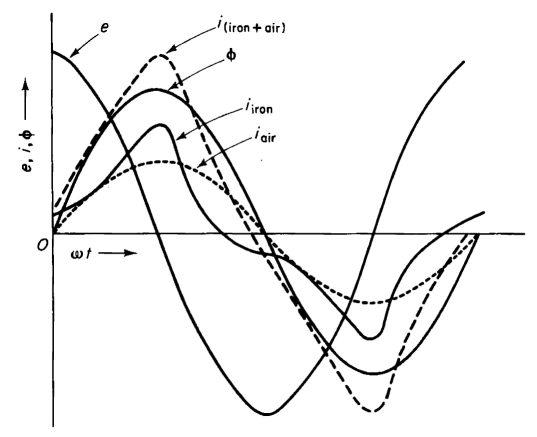| Capacitors, Magnetic Circuits, and Transformers is a free introductory textbook on the physics of capacitors, coils, and transformers. See the editorial for more information.... |

|

Home  Excitation Characteristics of Iron-Core Reactors Excitation Characteristics of Iron-Core Reactors  Effect of Air Gaps Effect of Air Gaps  Air Gap and Wave Form Air Gap and Wave Form |
|||||
| See also: Correction for Fringing at Short Air Gaps | |||||






|
|||||
Air Gap and Wave Form
The introduction of an air gap in a given iron circuit increases the fundamental component Imag1 in Fig. 5-9 without appreciably affecting the core-loss current Ic or the component (Imag - Imag1) in the magnetizing current resulting from the harmonics. Thus, the fundamental component is increased without increasing the harmonics, a condition that leads to a more nearly sinusoidal wave form for the exciting current. If the increase in the fundamental component of the magnetizing current produced by the air gap is Iair, Eq. 5-47 becomes
Figure 5-13 shows the components of exciting current Iiron for the iron, Iair for the air gap and the total exciting current I(iron + air) in a reactor or transformer with an iron core containing an air gap. The induced emf e and the flux Φ are both sinusoidal. The total exciting current I(iron + air) has a better wave form than the exciting current for the iron alone. It is important to note that the air-gap component current is in phase with the flux wave and is therefore also in phase with the fundamental harmonic of the magnetizing component in the exciting current required by the iron alone. Therefore, the magnetizing current Iair for the air gap adds directly to the fundamental harmonic Imag1 as indicated in Eq. 5-78.
|
|||||
Home  Excitation Characteristics of Iron-Core Reactors Excitation Characteristics of Iron-Core Reactors  Effect of Air Gaps Effect of Air Gaps  Air Gap and Wave Form Air Gap and Wave Form |
|||||
Last Update: 2011-02-16



